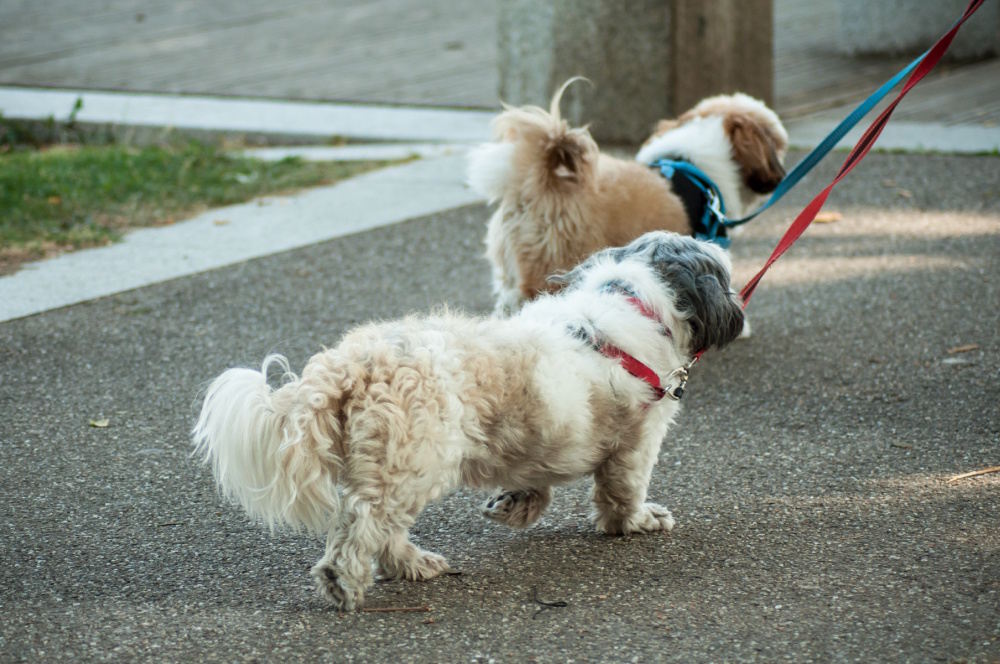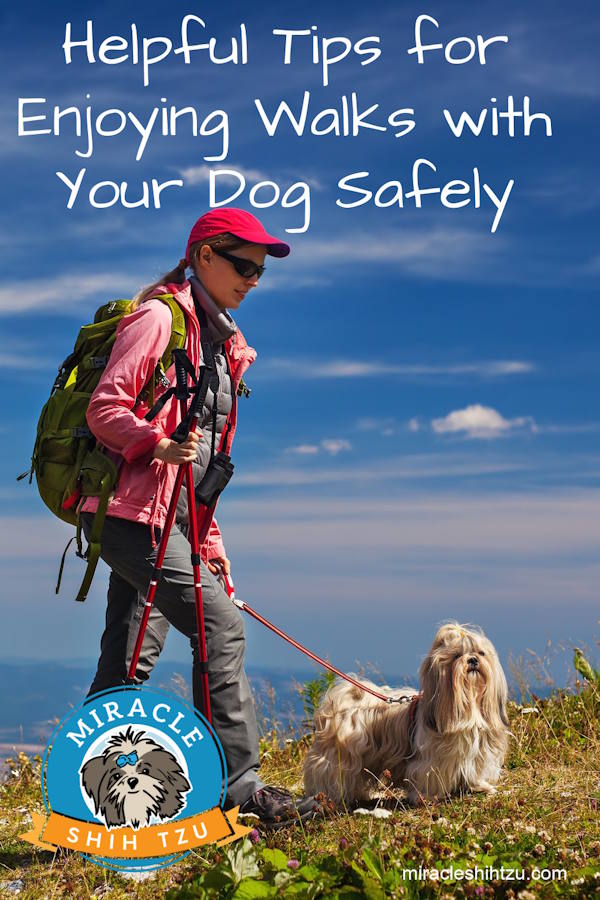- Home
- The Shih Tzu Lifestyle
- Walking Your Dog Safely
Helpful Tips for Enjoying Walks with Your Dog Safely
Taking your dog for a walk is one of the best ways to bond with them and help you both stay active. But while walks are fun and great for your pet’s physical and mental health, they also come with a few safety considerations. Whether you’re walking through busy neighbourhoods, facing unpredictable weather or trying to socialise your beloved pet with other animals, you need to take necessary precautions when you’re out and about.
In this handy guide, we’ll share practical, easy-to-follow tips to help you and your dog enjoy every step of your walk. From choosing the right collar and lead to reading your furry friend’s body language, we’re here to help you walk your dog safely and confidently.

Why Safe Dog Walking Matters More Than You Think
While a daily walk can sometimes seem like a chore to you, it’s actually one of the most important parts of your dog’s routine. Beyond physical exercise, walks provide mental stimulation, help your dog to socialise with others, and gives them a chance to explore their environment, which helps reduce anxiety and behavioural issues. But without keeping safety in mind, your dog’s daily exercise can quickly become stressful or dangerous for you both.
If you don’t take proper precautions, your outing can lead to accidents, injuries, or even confrontations with other animals or people. It’s important to always be aware of your surroundings and know when to act and when to avoid potential dangers so you can enjoy the rest of your walk. To give you extra peace of mind, it’s a good idea to have pet insurance in place, as this will act as a financial safety net should anything unexpected happen while you’re out and about with your furry friend. The costs of visiting the vet for any injuries or illness can mount up quickly, so this can be the best way to support paying for any treatment quickly, without adding further stress and worry.
Is Your Dog Ready for Outdoor Adventures?
Before you clip on that lead and head outside, you need to consider whether your pup is ready for walkies. Some dogs aren’t prepared for unfamiliar sights, noises and smells, which can cause them to become overwhelmed and potentially lash out or become scared. This may be because they’re young, newly adopted or have limited training. You may need to take extra time training them so that they’re at a level where going for a walk won’t cause them distress.
As per the PDSA, all dogs should be vaccinated against parvovirus, distemper, infectious hepatitis and leptospirosis. Some dogs may need additional vaccinations, especially if you are planning to travel with them outside of the UK or if your pet will be mixing with lots of other dogs in settings such as kennels. If your dog doesn’t have their full vaccinations, it’s not safe for them or other dogs if you take them out for walks.
Your dog needs to feel comfortable on a lead. If they pull, lunge, or panic on a lead, it’s a good idea to work on basic training before you take them out on regular walks, especially in busy areas. Similarly, reactive or nervous dogs may need gradual exposure and a bit of extra support.
Choose the Right Lead & Collar for Control and Comfort
When you’re choosing the right lead and collar (or harness) for your beloved pet, you need to consider factors such as behaviour and size. Collars are fine for dogs that walk calmly and don’t pull, whereas harnesses are much better for dogs that tend to pull, small breeds with delicate necks, or larger dogs that need more control. Whether you have a collar or harness, it needs to have an ID tag that contains your name, address and postcode written or engraved on it.
Your dog’s lead ideally needs to be around 4 to 6 feet long, as this gives them space to move around while still maintaining good control for you. If you want to give your beloved pet a bit more freedom, you may want to opt for a retractable lead, but this can reduce your control and so they’re not ideal for busy areas or untrained dogs.
For added comfort, you may want to choose a lead that has a padded handle. Your dog’s collar should be snug but not tight enough that you can’t slide two fingers under it.
How to Handle Off-Lead Dogs & Unexpected Encounters
Even if your dog is well-trained and on a lead, you may meet other off-lead dogs that aren’t friendly, or your dog doesn’t react well to. The most important thing is to stay calm, as panicking can trigger your dog. If a dog approaches you, keep your voice steady and avoid sudden movements, while also watching the approaching dog’s body language. Just because they’re wagging their tail doesn’t mean they’re always friendly. You shouldn’t let the dogs interact as not all dogs want or know how to greet others calmly, which can lead to growling, biting or even fighting.
If necessary, use firm, clear commands such as ‘no’ and ‘leave it’ to deter the off-lead dog. You may want to carry treats whenever you go on walks, as they can help you direct not just your dog but also the off-lead dog too.
Training your dog to follow a quick turnaround cue is worthwhile, as this will help you avoid potentially dangerous situations fast without causing you or them to panic. Ideally, you should try choosing routes or times with fewer distractions if you regularly walk where it’s common to see dogs off their leads.
What to Bring on a Dog Walk: Essentials Checklist
- Along with basics such as your dog’s collar and lead, it’s important to always keep a few essentials on hand, such as waste bags, treats, wipes and water with a collapsible bowl.
- Having a dog coat or jacket in cold weather, particularly if your dog’s breed has short hair, can help them stay warm and dry on their walk.
- If you’re going out at night or early in the morning when visibility is low, it’s a good idea to have reflective gear such as a hi-vis jacket and reflective collar or harness for your pet.
- Taking your mobile phone with you is also a great idea as it means you can quickly call for help if needed or use it to help you walk your way through a new or less familiar route.
Post-Walk Care & Time to Relax
When you eventually get home, it can be best to give your dog a check over, especially if you’ve been walking with them in a wooded area or through long grass. Wipe down their paws and fur to clean off any mud and check their paws, between toes, and under the belly for thorns, burrs, ticks, or small scrapes. After you’re done, make sure your dog has access to fresh, clean water and, finally, let them relax (as well as yourself!).
Checking over your dog after each walk helps make sure you notice any cuts or scratches early, before infection has a chance to set in. It will also help you notice anything else, such as limping or unusual lethargy. It only takes a few minutes, but it’s a great way to check the overall physical health of your furry companion. You know your dog better than anyone, so anything notably different you’ll spot quickly and can then speak to your vet.
Last Words
Feeling ready for a safer, more enjoyable walk? Hopefully, the above tips can go a long way to making your daily walks the perfect way to spend time with each other.
Pin Now, Walk Later
"Hi, I'm Janice Jones, a former veterinary technician and Shih Tzu expert with over 40 years of experience with the breed. Through Miracle Shih Tzu, I combine my medical background and extensive breed knowledge to provide reliable, practical advice for Shih Tzu owners. My mission is to help you give your Shih Tzu the happiest, healthiest life possible through evidence-based information and real-world solutions. Whether you're new to the breed or a seasoned owner, you'll find trusted guidance here for all aspects of Shih Tzu care.
I hold an undergraduate degree in Psychology with a minor in biology, Early Childhood Education, and Nursing, and a Master's in Mental Health Counseling.




